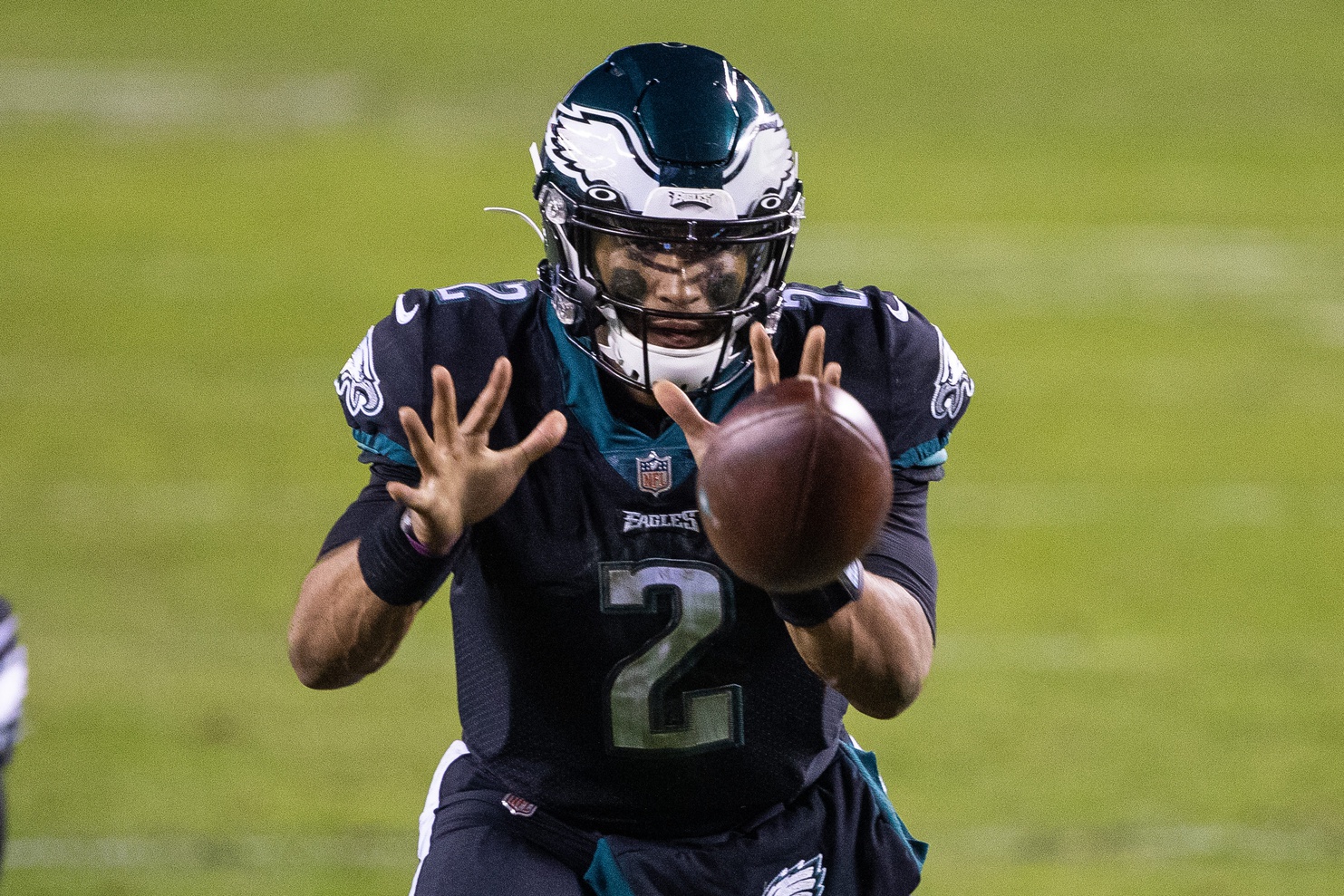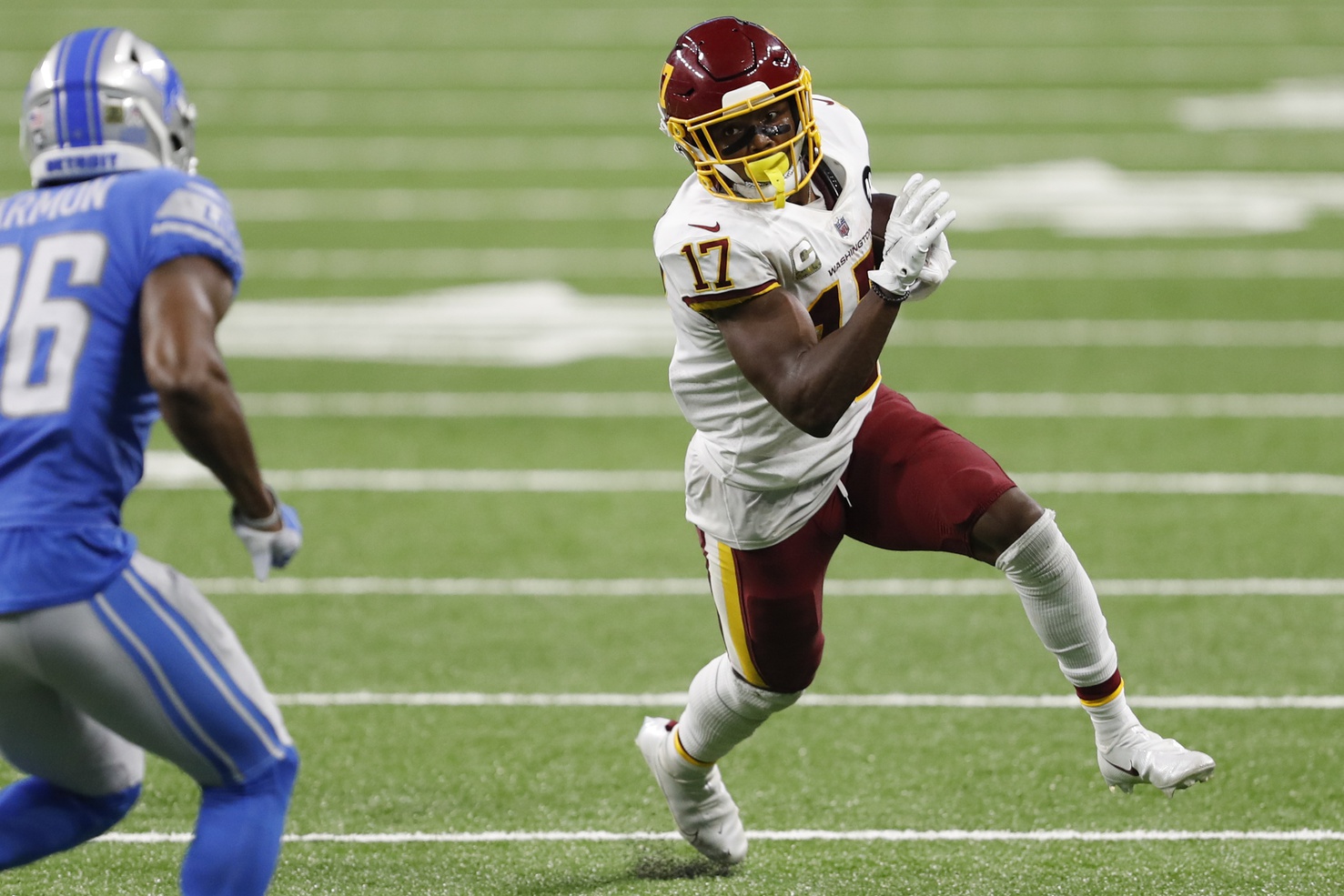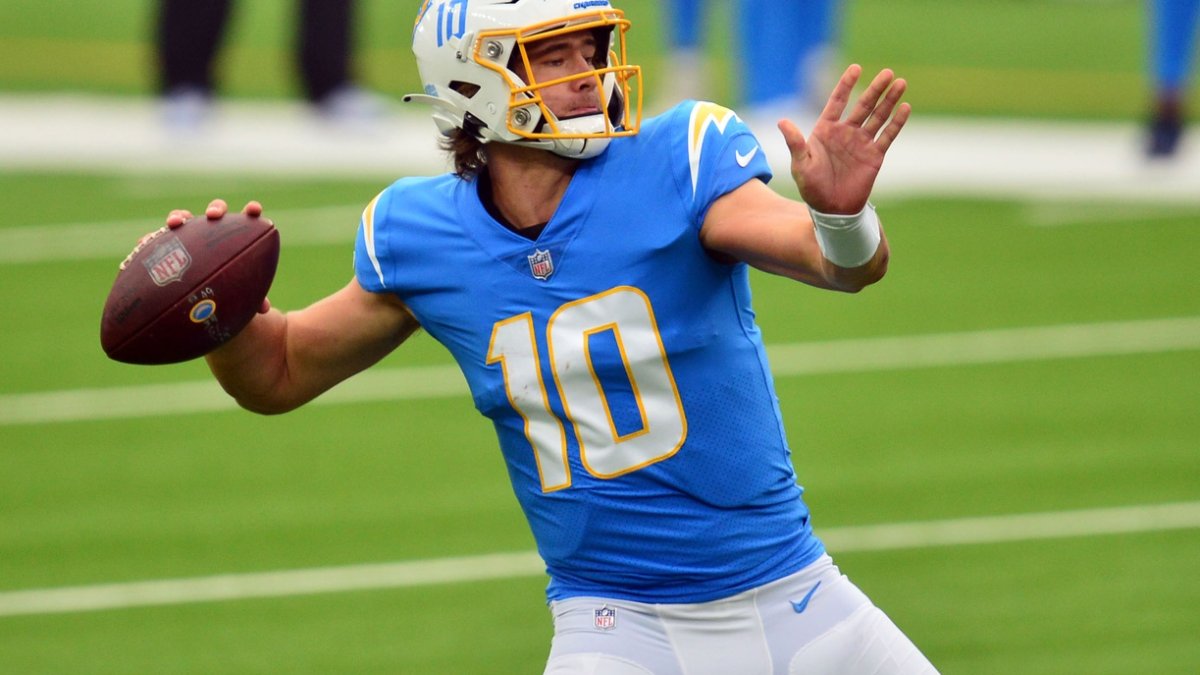The 2021 NFL Draft has done a number on my 2021 fantasy football rankings. New faces in new places have forced me to shake things up quite a bit in response to the new surroundings and outlooks, both for first-year players and veterans alike.
Subscribe to
I’ve already hit on some of my big rookie winners and losers from the draft, but seeing each player’s new ranking will provide additional insight and perspective on how to evaluate them heading into 2021.
Let's dive into the biggest risers and fallers in my 2021 best ball rankings and rookie dynasty rankings.
QUARTERBACKS
Justin Herbert‘s performance last season behind PFF’s 30th-ranked pass-blocking unit was truly remarkable. In 15 games, Herbert finished seventh in total fantasy points and led the NFL in PFF passing grade under pressure (75.4). His passer rating under pressure (99.4) was actually better than his passer rating from a clean pocket (97.7).
These types of metrics are extremely unstable at the quarterback position, it was easy to label Herbert a regression candidate because of his high-end efficiency under pressure.
I've had a slight change of heart after L.A. made a huge effort to revamp its OL. The additions of center Corey Linsley, guard Matt Feiler and first-round rookie tackle Rashawn Slater are massive upgrades.
The improvements in protection can only aid Herbert’s progress in his second season. He’s up to No. 6 in my quarterback rankings, ahead of Russell Wilson.
Jalen Hurts’ ADP has skyrocketed during the offseason, throttling the hopes of fantasy gamers who viewed him as a late-round QB option. Still, he’s priced appropriately, so he remains firmly in play after the team added first-round WR DeVonta Smith.
Smith is exactly what Hurts needs. Smith led all receivers in targets with at least two-plus steps of separation (88) in 2020. Hurts suffered from the lowest percentage of pass attempts delivered to “open” receivers last year (54%).
The Eagles rookie QB consistently attacked downfield anyway — 46 percent of his passing attempts were thrown 10-plus yards, No. 1 in the NFL. Luckily for him, Smith excels at hauling in targets downfield. Last year, the Heisman-winner graded as the best WR on targets of 10-plus yards (97.4).

The days of Hurts being a value are long gone, but Smith’s insertion into the Eagles’ offense dramatically increases his chances of hitting expectations. Hurts is a top-eight fantasy QB heading into 2021.
I rarely recommend drafting statuesque quarterbacks, but when I do they look like Matt Ryan. The offense is fully loaded and ready to take off in 2021 with Arthur Smith, Calvin Ridley, Julio Jones, Mike Davis and Kyle Pitts leading the way.
The Falcons playmakers are spread out in the early rounds of best ball drafts, making it easy to snag one or two and then complete the Falcons stack with Ryan later. He’s easily one of my favorite QBs to target outside the top 12. Just keep your fingers crossed that Jones isn't traded down the road.
Last season in games without a healthy Jones, Ryan posted a 67.2 PFF passing grade, 11 TDs, 8 INTs, a 82.9 passer rating and 6.6 yards per attempt. With Jones, Ryan posted a 90.9 PFF passing grade, 15 TDs, 3 INTs, a 106.4 passer rating and 8.3 yards per attempt.
Trey Lance and Justin Fields both moved up in my rankings after seeing their landing spots. Lance’s upside in Kyle Shanahan's offense seems nearly limitless, and Fields has a great chance of winning the starting job in Chicago over Andy Dalton.
We've seen much less talented quarterbacks function as fantasy options under the Matt Nagy regime. In his second season, Mitchell Trubisky finished seventh in fantasy points per dropback (0.55) and 12th in fantasy points per game (19.5).
If Trubisky can be a top-15 fantasy QB in his first season under Nagy, I’m confident Fields can.
One of my few major QB fallers from the draft — due in part to others rising — is quarterback Carson Wentz. The team didn’t address the tackle position, and they drafted two pass-catchers on Day 3. Many believe Wentz is bound to regain his past form under Frank Reich, but his current receiving corps is mediocre at best.
T.Y. Hilton, Michael Pittman Jr., Parris Campbell and Jack Doyle are not making me thrilled to draft Wentz in any fantasy format.
I feel similarly about Kirk Cousins after the Vikings decided to draft Kellen Mond in the third round. On the surface, it doesn’t seem like much, but reports suggesting that Minnesota wanted to trade up to acquire Fields were extremely telling. Cousins threw 10 interceptions in his first six games last season, so we could be just one or two implosion games away from Mond seeing time under center.
Both Wentz and Cousins are ranked well outside my top-20 quarterbacks.
RUNNING BACKS
There weren’t many big movers at the top of running back rankings after so many teams maintained the status quo in their respective backfields. The only major movement is Najee Harris entering the top 15 as the Pittsburgh Steelers’ next fantasy bell cow.
There are many similarities between Harris and Le’Veon Bell, from their size to their proficiency in the passing game. I can’t see the Steelers shying away from the Alabama product in any capacity.
The major concern for Harris and the Pittsburgh offense is the team's offensive line, but that's been blown out of proportion when it comes to the stud RB. Volume trumps efficiency at the running back position in fantasy football.
As PFF's Kevin Cole explained on Twitter, it's much harder to project efficiency, so take the certainty of volume. Betting on Harris getting a lion’s share of touches over the hodgepodge group of other Steelers running backs on the roster is a way better proposition than assuming the Pittsburgh O-line will rank 31st in run-blocking grade for a second-straight year.
Efficiency concerns for Najee Harris are likely overblown. It's much harder to project efficiency, so take the certainty of volume.
Le'Veon Bell was RB9 in PPR points per game as a rookie despite averaging 3.5 YPC and only scoring 8 total touchdowns
— Kevin Cole (@KevinColePFF) May 4, 2021
I can't move Harris higher in my dynasty rookie rankings because he’s always been my coveted 1.01.
One running back I haven’t been coveting this offseason is Miles Sanders, whose fantasy stock took another hit after the team drafted Kenneth Gainwell. I went into detail about Sanders in a piece on veterans impacted by 2021 rookie landing spots. After diving deeper into the messy situation, I was forced to bump Sanders down to RB22, four spots below his ADP.
Gainwell also fell in the overall ranks (RB50) and rookie ranks (27th overall) to a range where I won’t likely be drafting him at all this season. Having a pass-catching specialist attached to a mobile quarterback is just begging for frustration.
Mike Davis and Myles Gaskin rose into the top 25 running backs after both of their teams chose not to add any RB of consequence during the 2021 NFL Draft. Davis finished last season as the RB12 overall, and Gaskin was 12th in fantasy points per game (16.8).
Both players remain great values at their current ADPs. The Atlanta and Miami offenses on an upward trajectory, so RB1 upside is well within range for both of these backs.
The same can’t be said for Raheem Mostert, who has fallen in the rankings post-draft. He’s teetering in the middle-RB3 range (RB28) with plucky rookie Trey Sermon (RB29) hot on his tail.
Sermon rose nearly 20 spots in my best ball rankings and landed 12th overall in my rookie rankings after the San Francisco 49ers traded up to get their running back of the future.
Jets rookie running back Michael Carter was by far my biggest riser in both best ball (RB30) and dynasty rookie rankings (RB5). He might not be a complete workhorse, but he has the talent and pass-catching chops to be the 1A in the Jets backfield. Remember that he played well enough at North Carolina to keep Javonte Williams in a timeshare.
Carter is currently the RB38 per Underdog Fantasy ADP.
A low-key winner from the NFL Draft was Buffalo Bills running back Zack Moss. Despite several reports, the Bills wisely chose to not invest in the RB position, which puts Moss in the driver’s seat to lead the Buffalo backfield. That might not sound appealing to some, considering the Bills seemed to want nothing to do with running backs in their offense last year, but offenses can and do change.
What we know about the Bills is that they're going to score a lot. Fantasy production for RBs is often tied to the general state of the offense, so if the Bills’ O is firing on all cylinders we should expect to see decent to above-average fantasy production from Moss in Year 2.
WIDE RECEIVERS/TIGHT ENDS
T.J. Hockenson is going to be a force in fantasy football leagues this season. Here are the players he'll be competing with for targets: second-year wide receiver Quintez Cephus; opt-out returnee Geronimo Allison; fourth-round rookie Amon-Ra St. Brown; journeyman Breshad Perriman and veteran WR Tyrell Williams, who hasn’t caught more than 50 passes in a season since 2016.
That’s nobody’s idea of an elite receiving unit.
Over the past two seasons, Jared Goff has targeted the TE position at a 22% clip, which ranks 10th-highest since 2019. The new Lions quarterback also ranked fifth in passing yards (2,102) and fifth in total attempts (264) to TEs.
The Lions’ overall poor investment in their pass-catchers has also moved Perriman up the best ball rankings.
I don’t love the fit between Perriman and Goff because the latter has never taken advantage of vertical pass threats. He ranks 31st (9%) in pass-play percentage over 20 yards and 52nd out of 60 qualifying quarterbacks in aDOT (7.5) since 2019. Still, targets are available in this completely overhauled offense, and Perriman has often delivered in fantasy when given opportunities.
The former first-round pick can get open, as demonstrated by his No. 2-ranked PFF grade versus man coverage in 2019 (90.2). In Perriman’s last 12 games when he has commanded at least six targets, he has averaged 13.5 fantasy points per game.
Although the hype is building for St. Brown (he’s risen dramatically in the rookie draft rankings), don’t overlook the 27-year-old veteran in the late rounds of best ball drafts.
D.J. Moore was originally ranked inside my top 12 wide receivers, but the past few months haven't treated him well. No. 1: His quarterback is Sam Darnold. I’m extremely skeptical that Darnold can turn things around in just one year with Joe Brady. I don’t understand how Brady is somehow supposed to unlock the potential of a quarterback who has been downright awful during his entire NFL career in just one season.
Darnold is PFF’s 46th-graded quarterback (60.4) out of 55 qualifying QBs since entering the league in 2018.
Second, the team drafted alpha “X” wide receiver Terrace Marshall Jr., whom Brady coached at LSU. Marshall was a red-zone savant at the collegiate level, and I expect him to reprise that role in the NFL under a coach who is keen to his strengths.
I was hopeful that Moore’s touchdown woes would turn for the better in 2021, but given the circumstances he gets the downgrade. Robby Anderson also falls slightly in the rankings.
Terry McLaurin didn’t technically move in my rankings, but he’s worth mentioning because I'm lower on him versus ADP (WR12). McLaurin’s talent and production in his first two seasons is deserving of a top-12 draft slot, but I think there’s enough downside to his 2021 outlook that he could be slightly overvalued.

For starters, McLaurin is going to face legitimate target competition in this offense for the first time. He’s played with a lackluster supporting cast his entire NFL career and benefited greatly. With Curtis Samuel and third-rounder Dyami Brown added to the mix, F1 might not be a lock to see a WR1 target share every week.
Washington's fortress of a defense could also be detrimental to the offense as a whole if it eliminates shootouts and/or garbage time. Fewer high-scoring affairs means less volume on offense.
Other notable wide receivers who saw their rankings fall include Will Fuller, Tee Higgins, Marquise Brown, DeVante Parker, Christian Kirk, Denzel Mims, Sterling Shepard and Marvin Jones Jr.
Amari Rodgers, Josh Palmer and Nico Collins are some of the rookie wideouts who saw a rankings boost. Each was outside my top 25 overall rookies before the draft but moved up based on draft capital and landing spots.
The only major tight end movement among rookies was Brevin Jordan falling dramatically. I was extremely high on him, ranking the Miami product above Steelers rookie tight end Pat Friermuth. But Friermuth looks primed to take over the starting TE job in Pittsburgh as soon as 2022, while Jordan’s outlook remains much harder to project as a fifth-round selection by the Houston Texans.
In rookie drafts, I prefer Dolphins rookie tight end Hunter Long, who could also find a starting role next season with Mike Gesicki slated to hit free agency.
As for veteran tight ends in best ball, Cole Kmet, Anthony Firkser, Adam Trautman and Chris Herndon were all nudged upward. Gerald Everett, Hayden Hurst, Eric Ebron and Dan Arnold were pushed down after their teams invested draft capital into competing pass-catchers.



 © 2025 PFF - all rights reserved.
© 2025 PFF - all rights reserved.